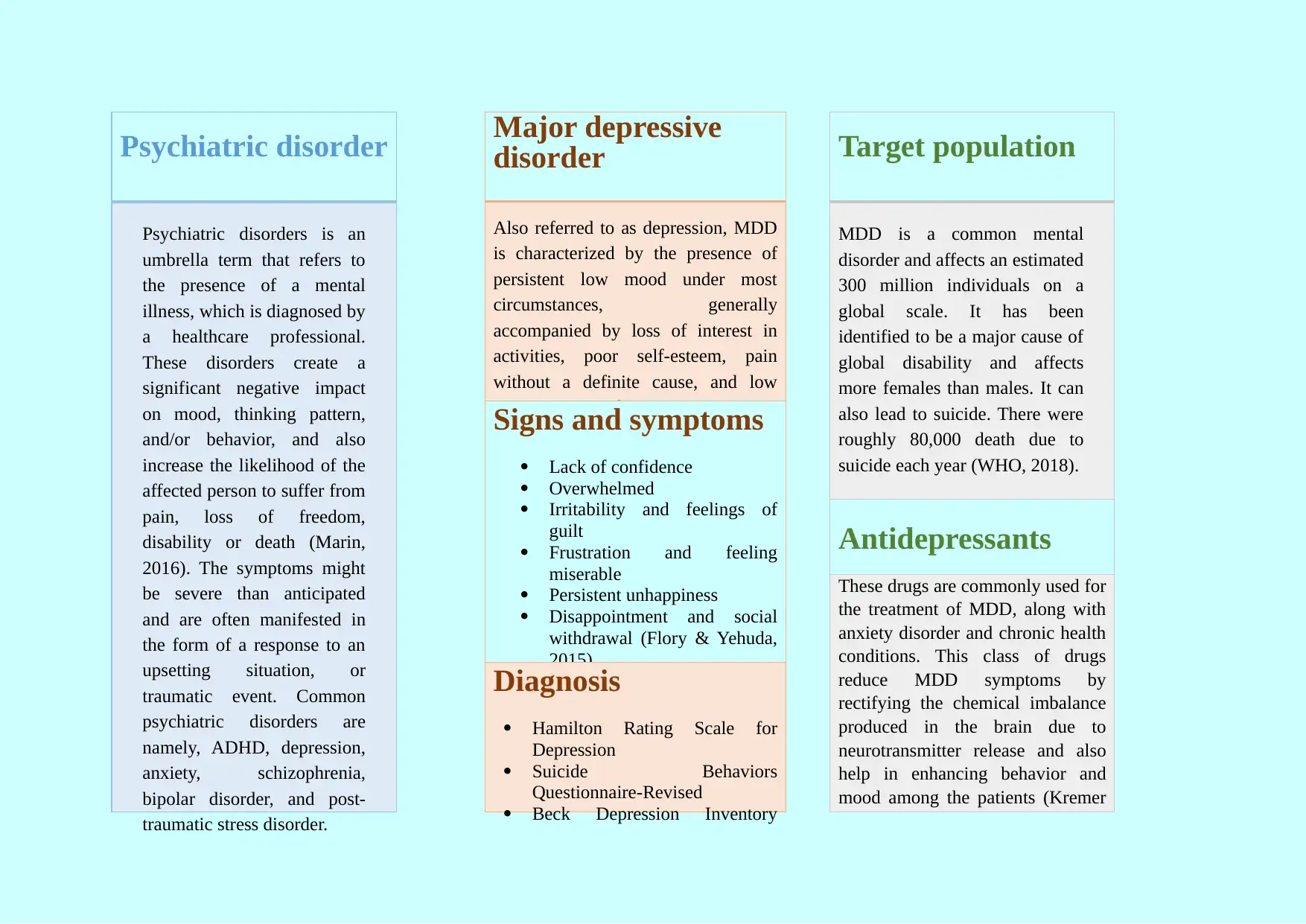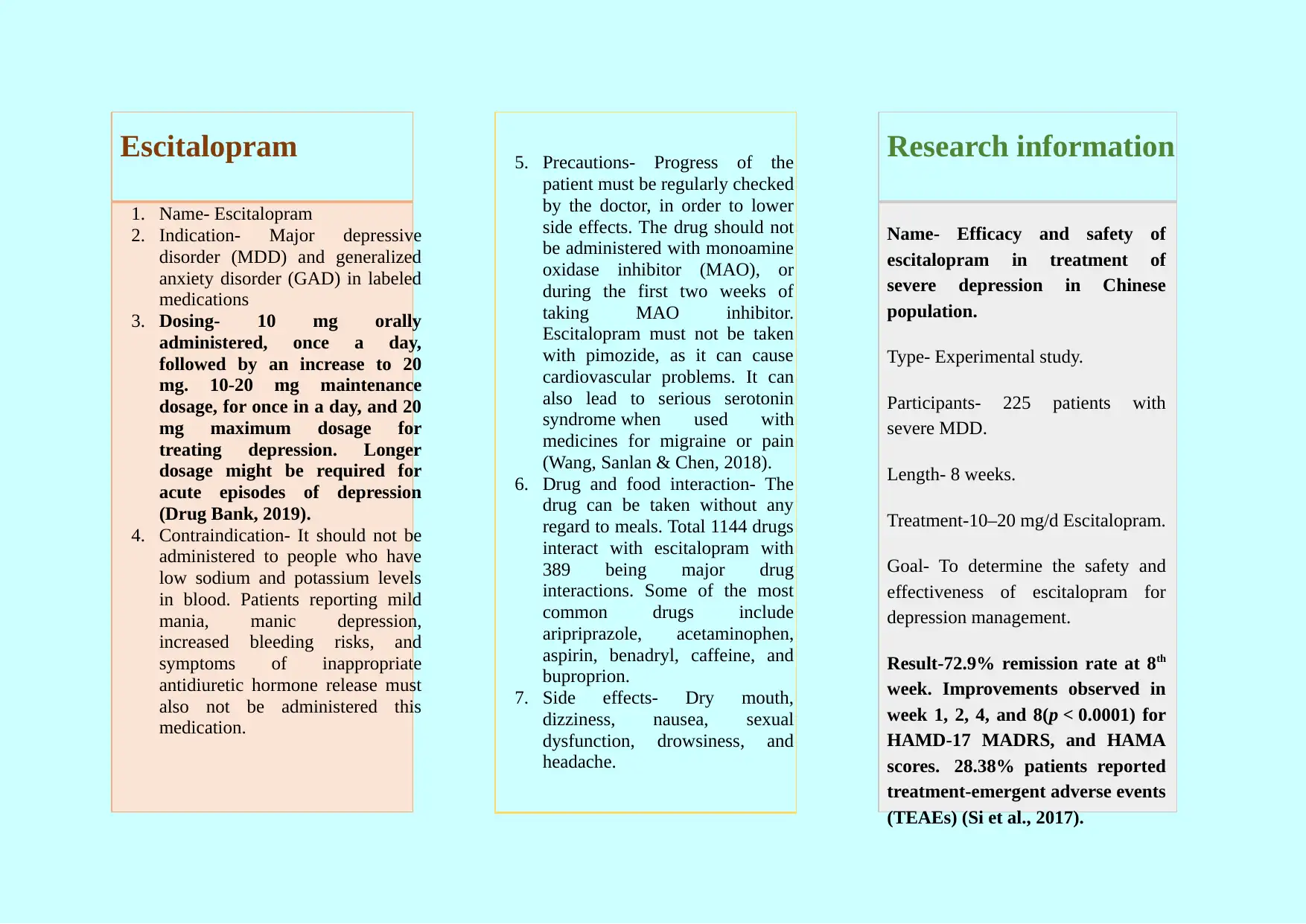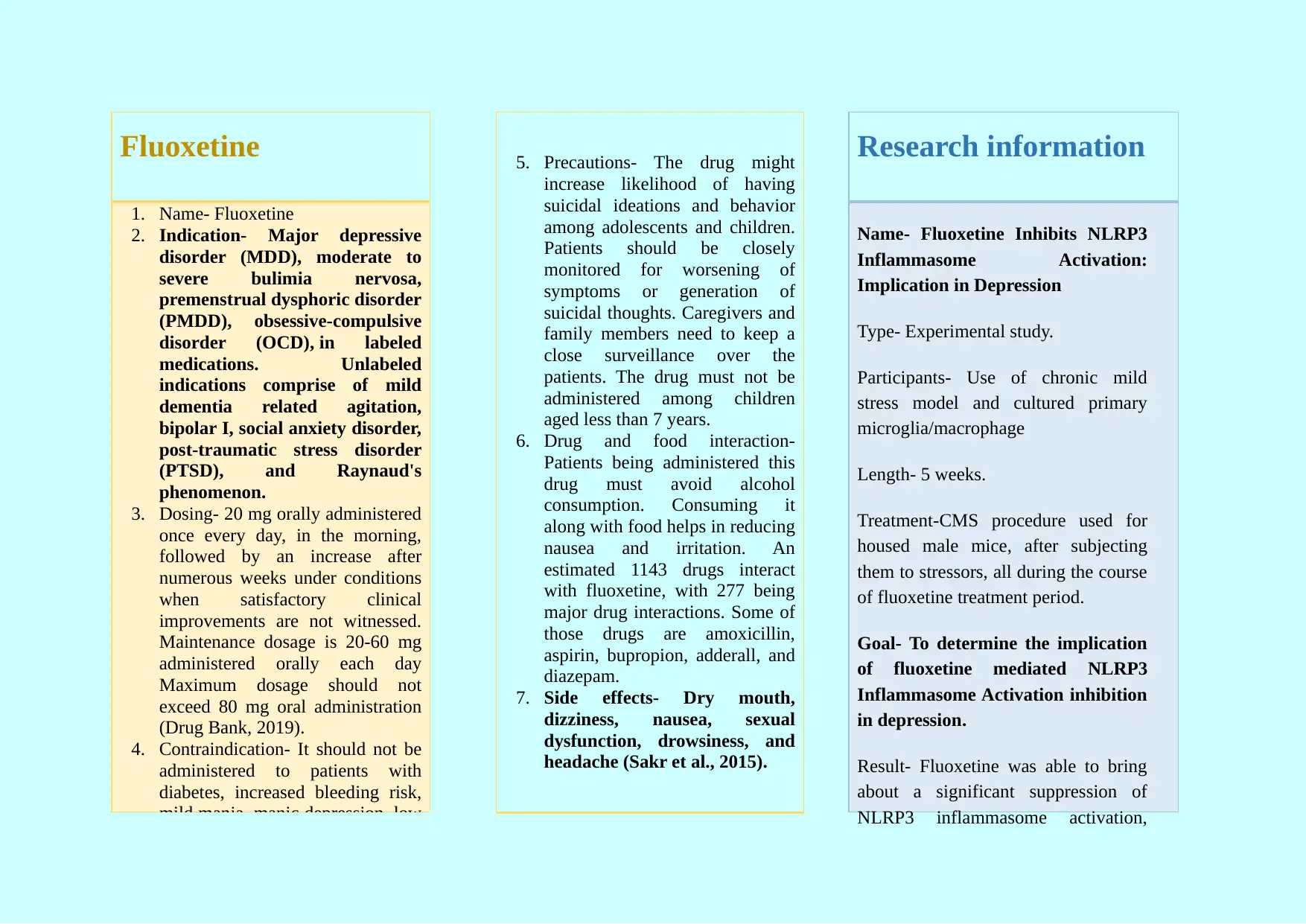NURS 613: Teaching Plan and Pamphlet on Psychotropic Agents
VerifiedAdded on 2022/12/26
|6
|2068
|4
Report
AI Summary
This report provides a comprehensive teaching plan on psychotropic agents, focusing on two key medications: escitalopram and fluoxetine. It begins by defining psychiatric disorders and outlining the characteristics of Major Depressive Disorder (MDD), including its symptoms, diagnostic criteria, and target population. The report then delves into the specifics of escitalopram and fluoxetine, detailing their indications, dosages, contraindications, precautions, drug and food interactions, and potential side effects. Research findings on the efficacy and safety of both drugs are also included. Furthermore, the report explains the mechanism of action of psychotropic agents, particularly Selective Serotonin Reuptake Inhibitors (SSRIs), like escitalopram and fluoxetine, in managing depression. The report also addresses the importance of accurate diagnosis before prescribing any medication, and concludes with a complete list of references. The assignment is designed to educate and inform healthcare professionals about the effective and safe usage of psychotropic agents.

Psychiatric disorder
Psychiatric disorders is an
umbrella term that refers to
the presence of a mental
illness, which is diagnosed by
a healthcare professional.
These disorders create a
significant negative impact
on mood, thinking pattern,
and/or behavior, and also
increase the likelihood of the
affected person to suffer from
pain, loss of freedom,
disability or death (Marin,
2016). The symptoms might
be severe than anticipated
and are often manifested in
the form of a response to an
upsetting situation, or
traumatic event. Common
psychiatric disorders are
namely, ADHD, depression,
anxiety, schizophrenia,
bipolar disorder, and post-
traumatic stress disorder.
Major depressive
disorder
Also referred to as depression, MDD
is characterized by the presence of
persistent low mood under most
circumstances, generally
accompanied by loss of interest in
activities, poor self-esteem, pain
without a definite cause, and low
energy (Otte et al., 2016).
Signs and symptoms
Lack of confidence
Overwhelmed
Irritability and feelings of
guilt
Frustration and feeling
miserable
Persistent unhappiness
Disappointment and social
withdrawal (Flory & Yehuda,
2015)
Diagnosis
Hamilton Rating Scale for
Depression
Suicide Behaviors
Questionnaire-Revised
Beck Depression Inventory
Target population
MDD is a common mental
disorder and affects an estimated
300 million individuals on a
global scale. It has been
identified to be a major cause of
global disability and affects
more females than males. It can
also lead to suicide. There were
roughly 80,000 death due to
suicide each year (WHO, 2018).
Antidepressants
These drugs are commonly used for
the treatment of MDD, along with
anxiety disorder and chronic health
conditions. This class of drugs
reduce MDD symptoms by
rectifying the chemical imbalance
produced in the brain due to
neurotransmitter release and also
help in enhancing behavior and
mood among the patients (Kremer
et al., 2016). Two common
Psychiatric disorders is an
umbrella term that refers to
the presence of a mental
illness, which is diagnosed by
a healthcare professional.
These disorders create a
significant negative impact
on mood, thinking pattern,
and/or behavior, and also
increase the likelihood of the
affected person to suffer from
pain, loss of freedom,
disability or death (Marin,
2016). The symptoms might
be severe than anticipated
and are often manifested in
the form of a response to an
upsetting situation, or
traumatic event. Common
psychiatric disorders are
namely, ADHD, depression,
anxiety, schizophrenia,
bipolar disorder, and post-
traumatic stress disorder.
Major depressive
disorder
Also referred to as depression, MDD
is characterized by the presence of
persistent low mood under most
circumstances, generally
accompanied by loss of interest in
activities, poor self-esteem, pain
without a definite cause, and low
energy (Otte et al., 2016).
Signs and symptoms
Lack of confidence
Overwhelmed
Irritability and feelings of
guilt
Frustration and feeling
miserable
Persistent unhappiness
Disappointment and social
withdrawal (Flory & Yehuda,
2015)
Diagnosis
Hamilton Rating Scale for
Depression
Suicide Behaviors
Questionnaire-Revised
Beck Depression Inventory
Target population
MDD is a common mental
disorder and affects an estimated
300 million individuals on a
global scale. It has been
identified to be a major cause of
global disability and affects
more females than males. It can
also lead to suicide. There were
roughly 80,000 death due to
suicide each year (WHO, 2018).
Antidepressants
These drugs are commonly used for
the treatment of MDD, along with
anxiety disorder and chronic health
conditions. This class of drugs
reduce MDD symptoms by
rectifying the chemical imbalance
produced in the brain due to
neurotransmitter release and also
help in enhancing behavior and
mood among the patients (Kremer
et al., 2016). Two common
Paraphrase This Document
Need a fresh take? Get an instant paraphrase of this document with our AI Paraphraser


Escitalopram
1. Name- Escitalopram
2. Indication- Major depressive
disorder (MDD) and generalized
anxiety disorder (GAD) in labeled
medications
3. Dosing- 10 mg orally
administered, once a day,
followed by an increase to 20
mg. 10-20 mg maintenance
dosage, for once in a day, and 20
mg maximum dosage for
treating depression. Longer
dosage might be required for
acute episodes of depression
(Drug Bank, 2019).
4. Contraindication- It should not be
administered to people who have
low sodium and potassium levels
in blood. Patients reporting mild
mania, manic depression,
increased bleeding risks, and
symptoms of inappropriate
antidiuretic hormone release must
also not be administered this
medication.
5. Precautions- Progress of the
patient must be regularly checked
by the doctor, in order to lower
side effects. The drug should not
be administered with monoamine
oxidase inhibitor (MAO), or
during the first two weeks of
taking MAO inhibitor.
Escitalopram must not be taken
with pimozide, as it can cause
cardiovascular problems. It can
also lead to serious serotonin
syndrome when used with
medicines for migraine or pain
(Wang, Sanlan & Chen, 2018).
6. Drug and food interaction- The
drug can be taken without any
regard to meals. Total 1144 drugs
interact with escitalopram with
389 being major drug
interactions. Some of the most
common drugs include
aripriprazole, acetaminophen,
aspirin, benadryl, caffeine, and
buproprion.
7. Side effects- Dry mouth,
dizziness, nausea, sexual
dysfunction, drowsiness, and
headache.
Research information
Name- Efficacy and safety of
escitalopram in treatment of
severe depression in Chinese
population.
Type- Experimental study.
Participants- 225 patients with
severe MDD.
Length- 8 weeks.
Treatment-10–20 mg/d Escitalopram.
Goal- To determine the safety and
effectiveness of escitalopram for
depression management.
Result-72.9% remission rate at 8th
week. Improvements observed in
week 1, 2, 4, and 8(p < 0.0001) for
HAMD-17 MADRS, and HAMA
scores. 28.38% patients reported
treatment-emergent adverse events
(TEAEs) (Si et al., 2017).
1. Name- Escitalopram
2. Indication- Major depressive
disorder (MDD) and generalized
anxiety disorder (GAD) in labeled
medications
3. Dosing- 10 mg orally
administered, once a day,
followed by an increase to 20
mg. 10-20 mg maintenance
dosage, for once in a day, and 20
mg maximum dosage for
treating depression. Longer
dosage might be required for
acute episodes of depression
(Drug Bank, 2019).
4. Contraindication- It should not be
administered to people who have
low sodium and potassium levels
in blood. Patients reporting mild
mania, manic depression,
increased bleeding risks, and
symptoms of inappropriate
antidiuretic hormone release must
also not be administered this
medication.
5. Precautions- Progress of the
patient must be regularly checked
by the doctor, in order to lower
side effects. The drug should not
be administered with monoamine
oxidase inhibitor (MAO), or
during the first two weeks of
taking MAO inhibitor.
Escitalopram must not be taken
with pimozide, as it can cause
cardiovascular problems. It can
also lead to serious serotonin
syndrome when used with
medicines for migraine or pain
(Wang, Sanlan & Chen, 2018).
6. Drug and food interaction- The
drug can be taken without any
regard to meals. Total 1144 drugs
interact with escitalopram with
389 being major drug
interactions. Some of the most
common drugs include
aripriprazole, acetaminophen,
aspirin, benadryl, caffeine, and
buproprion.
7. Side effects- Dry mouth,
dizziness, nausea, sexual
dysfunction, drowsiness, and
headache.
Research information
Name- Efficacy and safety of
escitalopram in treatment of
severe depression in Chinese
population.
Type- Experimental study.
Participants- 225 patients with
severe MDD.
Length- 8 weeks.
Treatment-10–20 mg/d Escitalopram.
Goal- To determine the safety and
effectiveness of escitalopram for
depression management.
Result-72.9% remission rate at 8th
week. Improvements observed in
week 1, 2, 4, and 8(p < 0.0001) for
HAMD-17 MADRS, and HAMA
scores. 28.38% patients reported
treatment-emergent adverse events
(TEAEs) (Si et al., 2017).
⊘ This is a preview!⊘
Do you want full access?
Subscribe today to unlock all pages.

Trusted by 1+ million students worldwide

Paraphrase This Document
Need a fresh take? Get an instant paraphrase of this document with our AI Paraphraser

Fluoxetine
1. Name- Fluoxetine
2. Indication- Major depressive
disorder (MDD), moderate to
severe bulimia nervosa,
premenstrual dysphoric disorder
(PMDD), obsessive-compulsive
disorder (OCD), in labeled
medications. Unlabeled
indications comprise of mild
dementia related agitation,
bipolar I, social anxiety disorder,
post-traumatic stress disorder
(PTSD), and Raynaud's
phenomenon.
3. Dosing- 20 mg orally administered
once every day, in the morning,
followed by an increase after
numerous weeks under conditions
when satisfactory clinical
improvements are not witnessed.
Maintenance dosage is 20-60 mg
administered orally each day
Maximum dosage should not
exceed 80 mg oral administration
(Drug Bank, 2019).
4. Contraindication- It should not be
administered to patients with
diabetes, increased bleeding risk,
mild mania, manic depression, low
5. Precautions- The drug might
increase likelihood of having
suicidal ideations and behavior
among adolescents and children.
Patients should be closely
monitored for worsening of
symptoms or generation of
suicidal thoughts. Caregivers and
family members need to keep a
close surveillance over the
patients. The drug must not be
administered among children
aged less than 7 years.
6. Drug and food interaction-
Patients being administered this
drug must avoid alcohol
consumption. Consuming it
along with food helps in reducing
nausea and irritation. An
estimated 1143 drugs interact
with fluoxetine, with 277 being
major drug interactions. Some of
those drugs are amoxicillin,
aspirin, bupropion, adderall, and
diazepam.
7. Side effects- Dry mouth,
dizziness, nausea, sexual
dysfunction, drowsiness, and
headache (Sakr et al., 2015).
Research information
Name- Fluoxetine Inhibits NLRP3
Inflammasome Activation:
Implication in Depression
Type- Experimental study.
Participants- Use of chronic mild
stress model and cultured primary
microglia/macrophage
Length- 5 weeks.
Treatment-CMS procedure used for
housed male mice, after subjecting
them to stressors, all during the course
of fluoxetine treatment period.
Goal- To determine the implication
of fluoxetine mediated NLRP3
Inflammasome Activation inhibition
in depression.
Result- Fluoxetine was able to bring
about a significant suppression of
NLRP3 inflammasome activation,
1. Name- Fluoxetine
2. Indication- Major depressive
disorder (MDD), moderate to
severe bulimia nervosa,
premenstrual dysphoric disorder
(PMDD), obsessive-compulsive
disorder (OCD), in labeled
medications. Unlabeled
indications comprise of mild
dementia related agitation,
bipolar I, social anxiety disorder,
post-traumatic stress disorder
(PTSD), and Raynaud's
phenomenon.
3. Dosing- 20 mg orally administered
once every day, in the morning,
followed by an increase after
numerous weeks under conditions
when satisfactory clinical
improvements are not witnessed.
Maintenance dosage is 20-60 mg
administered orally each day
Maximum dosage should not
exceed 80 mg oral administration
(Drug Bank, 2019).
4. Contraindication- It should not be
administered to patients with
diabetes, increased bleeding risk,
mild mania, manic depression, low
5. Precautions- The drug might
increase likelihood of having
suicidal ideations and behavior
among adolescents and children.
Patients should be closely
monitored for worsening of
symptoms or generation of
suicidal thoughts. Caregivers and
family members need to keep a
close surveillance over the
patients. The drug must not be
administered among children
aged less than 7 years.
6. Drug and food interaction-
Patients being administered this
drug must avoid alcohol
consumption. Consuming it
along with food helps in reducing
nausea and irritation. An
estimated 1143 drugs interact
with fluoxetine, with 277 being
major drug interactions. Some of
those drugs are amoxicillin,
aspirin, bupropion, adderall, and
diazepam.
7. Side effects- Dry mouth,
dizziness, nausea, sexual
dysfunction, drowsiness, and
headache (Sakr et al., 2015).
Research information
Name- Fluoxetine Inhibits NLRP3
Inflammasome Activation:
Implication in Depression
Type- Experimental study.
Participants- Use of chronic mild
stress model and cultured primary
microglia/macrophage
Length- 5 weeks.
Treatment-CMS procedure used for
housed male mice, after subjecting
them to stressors, all during the course
of fluoxetine treatment period.
Goal- To determine the implication
of fluoxetine mediated NLRP3
Inflammasome Activation inhibition
in depression.
Result- Fluoxetine was able to bring
about a significant suppression of
NLRP3 inflammasome activation,

⊘ This is a preview!⊘
Do you want full access?
Subscribe today to unlock all pages.

Trusted by 1+ million students worldwide
1 out of 6
Related Documents
Your All-in-One AI-Powered Toolkit for Academic Success.
+13062052269
info@desklib.com
Available 24*7 on WhatsApp / Email
![[object Object]](/_next/static/media/star-bottom.7253800d.svg)
Unlock your academic potential
Copyright © 2020–2026 A2Z Services. All Rights Reserved. Developed and managed by ZUCOL.




